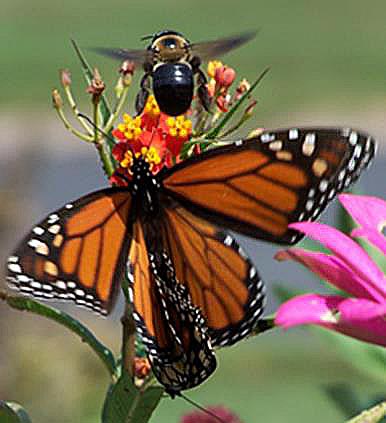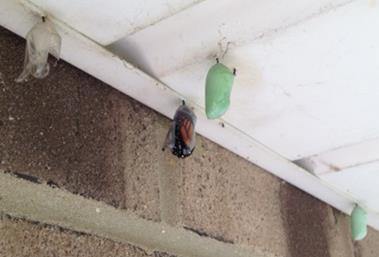Observations From a Butterfly Garden
By Christine Ramoski, Fairfax Master Gardener
My fascination with butterflies grew out of an interest in bugs in general. One year, without much planning, I planted a butterfly bush (Buddleia). It didn’t take long for the butterflies to find it. The next year, I created a puddling pool, using a large, terracotta-pot saucer and some sand, clay and river stones. I observed the butterflies drinking from the moist earth and basking on the stones. What an easy and cheap form of entertainment! I also observed caterpillars on my dill and parsley plants. After some research, I realized those caterpillars were the larvae of swallowtail butterflies.

Mating Monarchs with hovering observer
I then began researching the importance of native plants and host plants for butterflies. I spent time determining what host plants would lure the best variety of butterflies to my yard. Eventually, I thought, what are the chances that I could entice at least one generation of the monarch to hang out in my yard? I planted their host plant, milkweed (Asclepias), and the monarchs came. Each year, I spend a little more time observing, raising and encouraging the monarchs in my yard. Each year, I spend less time planting. As I don’t use chemicals to control weeds in my yard, my annual flowers easily reseed themselves. Much of what comes up in my yard — host as well as nectar plants — does not cost me any money, and my garden is full of color.
In June, I begin looking for the first adult monarch in my yard, hoping to beat the prior year’s first-spotting date. Then, starting in August, I begin searching for and counting monarch chrysalises, eager to find more than in the previous year. September is a busy month, with several adult monarchs hatching each day. Last year, I had more than 60 chrysalises attached to the house siding in easy view.
This February, as I was pruning, I was thrilled to find many more chrysalises hidden in my trees and shrubs. The monarch chrysalises and the praying mantis egg sacs were abundant. For the chrysalises that did not hatch out, the frost nipped those tiny lives; however, the praying mantis egg sacs will be hatching as the spring weather starts to warm. These artifacts in my yard are proof that nature balances itself. During the summer, the mantises are 5 or 6 inches long, and I have no doubt that the nourishment provided by some of those monarch larvae, and the absence of insecticides in my yard, contribute to their size. I am, however, thankful that I have not had the experience of witnessing one of these meals taking place.

Monarch chrysalises in various stages of development
The last observation I will share of my butterfly garden is the extent in which neighbors take interest. My gardens are a great conversation starter, and I find it flattering to have people hovering at my sidewalk beds. My gardens are not “tidy” as the intent is to attract wildlife. This does not seem to matter to my neighbors. In fact, it is the activity of my garden that keeps my neighbors’ interest.
I once spotted an 8-year-old girl, dressed in a Princess Jasmine Halloween costume, standing near my butterfly garden. Upon seeing me, she shouted, “Do you know that you have monarchs in your garden?” Intrigued, I went over to find out what she knew about this butterfly. “I learned about them in school, but perhaps we can talk some other time because I have to join the neighborhood hotdog party before trick-or-treating starts.”

Adult praying mantis
My young visitor may not have been aware that back in June 2007, Canada, Mexico and the United States collaborated to develop the North American Monarch Conservation Plan. Their joint effort is likely the reason why she and other schoolchildren in the U.S. today learn about the monarch lifecycle. (I invite you to educate yourself more on the monarchs’ plight and how we are now trying to reverse human impact on this creature.)
I often encourage well-behaved visitors to walk through my yard, to share in the new things that occur in the gardens each day. However, despite how easy it is to attract monarchs, some folks don’t want to wait or take the effort to plant a seed. I have often discovered and, in turn, learned to laugh about missing parts of my milkweed – parts that had had an established larva attached. What I hope the human bandits understand is that it takes about two whole milkweed plants to get that caterpillar to the state in which it is ready to leave the host and form a chrysalis. Raising monarchs outside of the garden can become a large obligation rather quickly.
See my story, A Beginner’s Guide to Butterfly Gardens, for more information about starting your own butterfly garden.
Resources
North American Monarch Conservation Plan, Commission for Environmental Cooperation
Monarch Larva Monitoring Project, University of Minnesota
Pollinator Partnership fueling station
Pollinator Partnership zip code